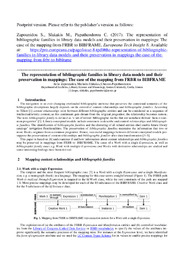The representation of bibliographic families in library data models and their preservation in mappings : the case of the mapping from FRBR to BIBFRAME
Abstract
The navigation in an ever-changing overloaded bibliographic universe that preserves the contextual semantics of the bibliographic descriptions largely depends on the control of content relationships and bibliographic families. According to Tillett [1] content relationships exist between different bibliographic entities and can be considered as a sequence of intellectual/artistic content; as this continuum gets distant from the original progenitor, the relationship becomes remote. The term bibliographic family is defined as ‘a set of related bibliographic works that are somehow derived from a common progenitor’ [2]. Library conceptual models include constructs to describe and control relationships and biblio-graphic families. The identification of bibliographic families and the clustering of all related entities shall enable future library catalogs’ navigation functionalities. The preservation of bibliographic families maintains the information that two or more Works originate from a common progenitor. Hence, successful mappings between different conceptual models pre-suppose the preservation of content relationships and bibliographic families after data transformation [3–5]. This paper is based on [6] and examines if and how information about content relationships and bibliographic fami-lies may be preserved in mappings from FRBR to BIBFRAME. The cases of a Work with a single Expression, as well as bibliographic family cases e.g. Work with multiple Expressions and Works with derivative relationships are studied and some interesting findings have been derived.
Collections
- Περιοδικά, εφημερίδες [1351]
